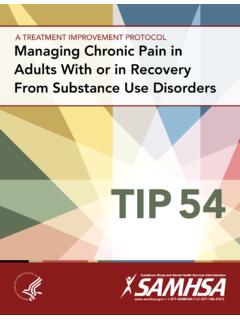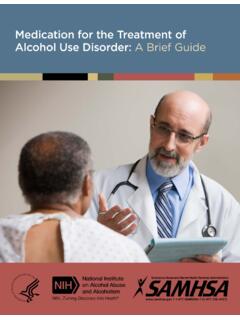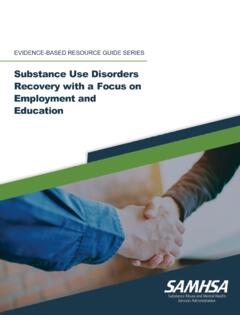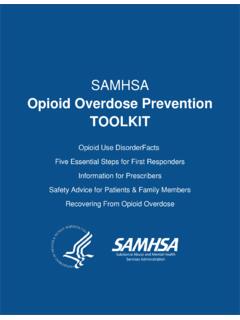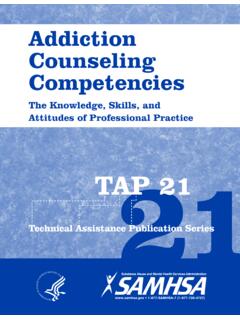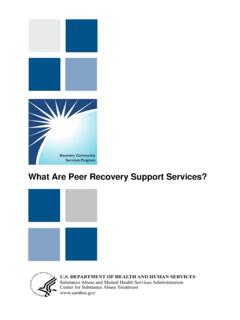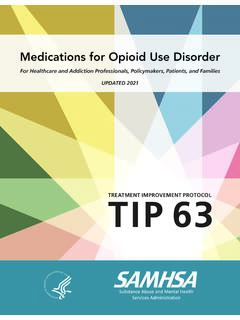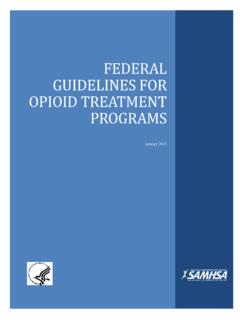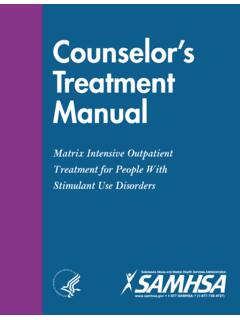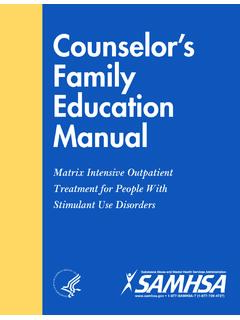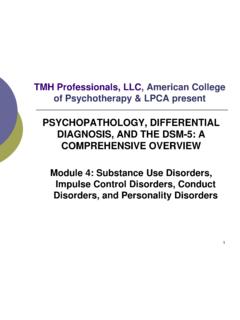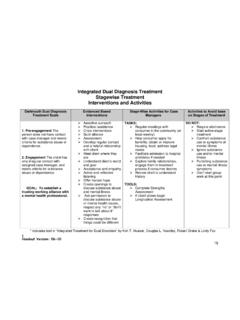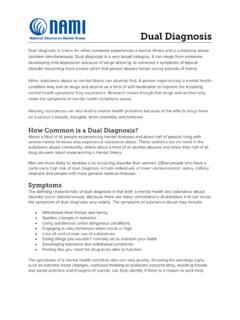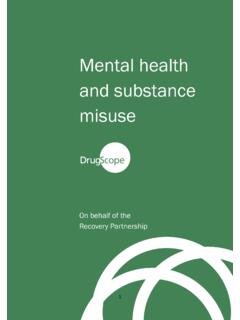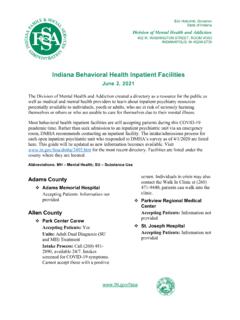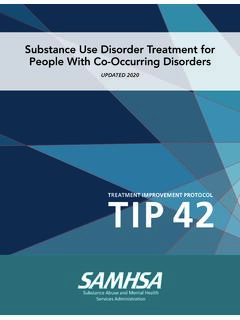Transcription of Integrated Treatment for Co-Occurring Disorders: The Evidence
1 Integrated Treatment for Co-Occurring DisordersThe DEPARTMENT OF HEALTH AND HUMAN SERVICESS ubstance Abuse and mental Health Services AdministrationCenter for mental Health Treatment for Co-Occurring DisordersThe Department of Health and Human Services substance Abuse and mental Health Services Administration Center for mental Health ServicesAcknowledgmentsThis document was produced for the substance Abuse and mental Health Services Administration (SAMHSA) by the New Hampshire-Dartmouth Psychiatric Research Center under contract number 280-00-8049 and Westat under contract number 270-03-6005, with SAMHSA, Department of Health and Human Services (HHS). Neal Brown, , and Crystal Blyler, , served as the Government Project views, opinions, and content of this publication are those of the authors and contributors and do not necessarily reflect the views, opinions, or policies of the Center for mental Health Services (CMHS), SAMHSA, or Domain NoticeAll material appearing in this document is in the public domain and may be reproduced or copied without permission from SAMHSA.
2 Citation of the source is appreciated. However, this publication may not be reproduced or distributed for a fee without the specific, written authorization from the Office of Communications, SAMHSA, Access and Copies of PublicationThis publication may be downloaded or ordered at Or, please call SAMHSA s Health Information Network at 1-877-SAMHSA-7 (1-877-726-4727) (English and Espa ol).Recommended CitationSubstance Abuse and mental Health Services Administration. Integrated Treatment for Co-Occurring Disorders: The Evidence . DHHS Pub. No. SMA-08-4366, Rockville, MD: Center for mental Health Services, substance Abuse and mental Health Services Administration, Department of Health and Human Services, Office Center for mental Health Services substance Abuse and mental Health Services Administration 1 Choke Cherry Road Rockville, MD 20857 DHHS Publication No.
3 SMA-08-4366 Printed 2009 Integrated Treatment for Co-Occurring DisordersThe EvidenceThe Evidence introduces all stakeholders to the research literature and other resources on Integrated Treatment for Co-Occurring Disorders. This booklet includes the following: Two key resources included in the KIT; Additional resources for further reading; and References for the citations presented throughout the KIT is part of a series of Evidence -Based Practices KITs created by the Center for mental Health Services, substance Abuse and mental Health Services Administration, Department of Health and Human booklet is part of the Integrated Treatment for Co-Occurring Disorders KIT that includes a DVD, CD-ROM, and seven booklets:How to Use the Evidence -Based Practices KITsGetting Started with Evidence -Based PracticesBuilding Your ProgramTraining Frontline StaffEvaluating Your ProgramThe EvidenceUsing Multimedia to Introduce Your EBPI ntegrated Treatment for Co-Occurring DisordersWhat s in The EvidenceReview of Research Literature.
4 1 Selected Bibliography ..11 References ..23 Acknowledgments ..27 The EvidenceReview of Research LiteratureA number of research articles summarize the effectiveness of Integrated Treatment for Co-Occurring Disorders. This KIT includes a full text copy of one of them:Drake, R. E., Essock, S. M., Shaner, A., Carey, K. B., Minkoff, K., Kola, L., et al. (2001). Implementing dual diagnosis services for clients with severe mental illness . Psychiatric Services, 52(4), 469-476. This article describes the critical components of the Evidence -based model and its effectiveness. Barriers to implementation and strategies for overcoming them are also discussed, based on experiences in several states. This article may be viewed or printed from the CD-ROM in your KIT. For a printed copy, see page Evidence 1 Review of Research LiteratureCenter for substance Abuse Treatment , substance Abuse Treatment for Persons with Co-Occurring Disorders, Treatment Improvement Protocol (TIP) Series 42, DHHS Publication No.
5 (SMA) 05-3992, Rockville, MD: substance Abuse and mental Health Services Administration, to this KIT, TIP 42 is a guide that provides resources for treating Co-Occurring mental illnesses and substance use disorders. It is an excellent complement to the Integrated Treatment KIT. The primary audiences for TIP 42 are substance abuse Treatment practitioners with varying degrees of education and experience. Secondary audiences are policymakers and other professionals who work with consumers who have Co-Occurring disorders. TIP 42 summarizes state-of-the-art Treatment of Co-Occurring disorders. It has chapters on terminology, assessment, and Treatment strategies and gives suggestions for policy planning. Concepts, models, and strategies outlined in TIP 42 are based on definitive research, empirical support, and agreements of a consensus panel.
6 Successful models of Treatment are portrayed and specific consensus panel recommendations are cited throughout the 42 is accompanied by four supplements: Quick Guide for Administrators Based on TIP 42: substance Abuse Treatment for Persons with Co-Occurring Disorders; Quick Guide for Clinicians Based on TIP 42: substance Abuse Treatment for Persons with Co-Occurring Disorders; substance Abuse Treatment for Persons with Co-Occurring Disorders: In-Service Training Based on a Treatment Improvement Protocol Tip 42; and Knowledge Application Program (KAP) Keys for Clinicians Based on TIP 42: substance Abuse Treatment for Persons with Co-Occurring Disorders. For a copy of TIP 42 and the supplemental guides for the TIP, see the CD-ROM in this KIT or go to of Research Literature 2 The EvidenceThe Evidence 3 Review of Research LiteraturePSYCHIATRIC SERVICESA pril 2001 Vol.
7 52 No. 4469 Implementing dual DiagnosisServices for Clients With Severe mental IllnessRobert E. Drake, , M. Essock, Shaner, B. Carey, Minkoff, Kola, Lynde, C. Osher, E. Clark, Rickards, 20 years of development and research, dual diagnosis servicesfor clients with severe mental illness are emerging as an Evidence -based practice. Effective dual diagnosis programs combine mentalhealth and substance abuse interventions that are tailored for thecomplex needs of clients with comorbid disorders. The authors de-scribe the critical components of effective programs, which include acomprehensive, long-term, staged approach to recovery; assertive out-reach; motivational interventions; provision of help to clients in ac-quiring skills and supports to manage both illnesses and to pursuefunctional goals; and cultural sensitivity and competence.
8 Many statemental health systems are implementing dual diagnosis services, buthigh-quality services are rare. The authors provide an overview of thenumerous barriers to implementation and describe implementationstrategies to overcome the barriers. Current approaches to imple-menting dual diagnosis programs involve organizational and financingchanges at the policy level, clarity of program mission with structuralchanges to support dual diagnosis services, training and supervisionfor clinicians, and dissemination of accurate information to consumersand families to support understanding, demand, and advocacy. (Psy-chiatric Services52:469 476, 2001) substance abuse is the most com-mon and clinically significantcomorbid disorder among adultswith severe mental illness .
9 In this pa-per the term substance abuse refersto substance use disorders, which in-clude abuse and dependence. Se-vere mental illness refers to long-term psychiatric disorders, such asschizophrenia, that are associatedwith disability and that fall within thetraditional purview of public mentalhealth systems. Finally, the term dual diagnosis denotes the co-oc-currence of substance abuse and se-vere mental illness . There are many populations withdual diagnoses, and there are othercommon terms for this particulargroup. Furthermore, dual diagnosis isa misleading term because the indi-viduals in this group are heteroge-neous and tend to have multiple im-pairments rather than just two illness -es. Nevertheless, the term appearsconsistently in the literature and hasacquired some coherence as a refer-ent to particular clients, treatments,programs, and service system issues.
10 Since the problem of dual diagnosisbecame clinically apparent in the ear-ly 1980s (1,2), researchers have estab-lished three basic and consistent find-ings. First, co-occurrence is common;Dr. Drakeand Dr. Clarkare affiliated with the New Hampshire Dartmouth Psychi-atric Research Center, 2 Whipple Place, Lebanon, New Hampshire 03766 Dr. Essockis with Mt. Sinai Medical School in NewYork City. Dr. Shaneris affiliated with the School of Medicine at the University of Cal-ifornia, Los Angeles. Dr. Careyis with Syracuse University in New York. Dr. Minkoffisin private practice in Boston. Dr. Kolais with Case Western Reserve University in Cleve-land, Ohio. Mr. Lyndeis with West Institute in Concord, New Hampshire. Dr. Osheriswith the University of Maryland School of Medicine in Baltimore.
